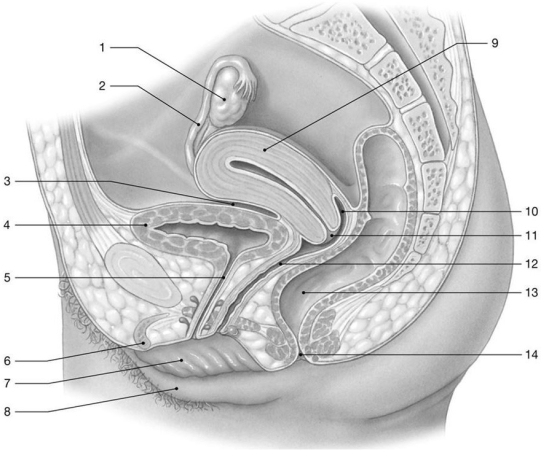A) dysmenorrhea.
B) detumescence.
C) menopause.
D) menses.
E) amenorrhea.
Correct Answer

verified
Correct Answer
verified
Multiple Choice
Secondary spermatocytes each contain
A) 23 chromosomes.
B) 23 pairs of chromosomes.
C) twice the diploid number of chromosomes.
D) 46 pairs of chromosomes.
E) 46 chromosomes.
Correct Answer

verified
Correct Answer
verified
Multiple Choice
Figure 28-2 The Female Reproductive System
 Use Figure 28-2 to answer the following questions:
-Identify the structure labeled "12."
Use Figure 28-2 to answer the following questions:
-Identify the structure labeled "12."
A) uterus
B) vagina
C) clitoris
D) labium minus
E) ovary
Correct Answer

verified
Correct Answer
verified
Multiple Choice
Which of the following descriptions best matches the term uterine tube?
A) has ciliated epithelium
B) has stratified squamous epithelium
C) covers the glans penis or glans clitoris
D) holds the uterus to the ovary
E) passes through erectile tissue in females
Correct Answer

verified
Correct Answer
verified
Multiple Choice
Where in the male reproductive system would you expect to find the most mature sperm?
A) in the seminiferous tubules
B) in the head of the epididymis
C) near the tail of the epididymis
D) in the seminal gland
E) in the prostate gland
Correct Answer

verified
Correct Answer
verified
Multiple Choice
The organ that monitors and adjusts the composition of tubular fluid, recycles damaged sperm, and is thesite of sperm maturation is the
A) ductus deferens.
B) rete testis.
C) seminal gland (seminal vesicle) .
D) epididymis.
E) prostate gland.
Correct Answer

verified
Correct Answer
verified
Multiple Choice
The reproductive system includes all of the following except
A) gonads and external genitalia.
B) ducts that receive and transport the gametes.
C) accessory glands and organs that secrete fluids.
D) organs for copulation.
E) glands and organs that produce and store urine.
Correct Answer

verified
Correct Answer
verified
Multiple Choice
During the menstrual phase,
A) progesterone levels are high.
B) a new uterine lining is formed.
C) secretory glands and blood vessels develop in the endometrium.
D) the old functional layer is sloughed off.
E) the corpus luteum is most active.
Correct Answer

verified
Correct Answer
verified
Multiple Choice
The nurse cells of the seminiferous tubules do all of the following except
A) maintain the blood testis barrier.
B) support spermiogenesis.
C) secrete inhibin.
D) secrete testosterone.
E) secrete androgen-binding protein.
Correct Answer

verified
Correct Answer
verified
Multiple Choice
The ________ are fingerlike projections that capture the freshly ovulated ovum.
A) gubernaculum
B) fimbriae
C) infundibulum
D) uterine horn
E) uterine tunnel
Correct Answer

verified
Correct Answer
verified
Multiple Choice
The PSA test is used for diagnosis of
A) testicular cancer.
B) penile cancer.
C) prostatitis.
D) premature puberty.
E) prostate cancer.
Correct Answer

verified
Correct Answer
verified
Multiple Choice
Figure 28-2 The Female Reproductive System
 Use Figure 28-2 to answer the following questions:
-Identify the structure labeled "2."
Use Figure 28-2 to answer the following questions:
-Identify the structure labeled "2."
A) vagina
B) uterine tube
C) clitoris
D) ureter
E) ovary
Correct Answer

verified
Correct Answer
verified
Multiple Choice
In a 28 day cycle, ovulation typically occurs around day
A) 3.
B) 7.
C) 14.
D) 21.
E) 28.
Correct Answer

verified
Correct Answer
verified
Multiple Choice
Rachel is experiencing difficulty conceiving. All of the following may be reasons why, except
A) her pituitary gland is not producing adequate levels of FSH.
B) her ovarian and menstrual cycles are not properly coordinated.
C) her ovaries are not producing enough progesterone.
D) she has a 28 day cycle.
E) her ovaries are not producing enough estrogen.
Correct Answer

verified
Correct Answer
verified
Multiple Choice
Figure 28-2 The Female Reproductive System
 Use Figure 28-2 to answer the following questions:
-In which structure does gestation occur?
Use Figure 28-2 to answer the following questions:
-In which structure does gestation occur?
A) 1
B) 4
C) 9
D) 11
E) 13
Correct Answer

verified
Correct Answer
verified
Multiple Choice
An inflammation of the vaginal canal caused by fungi, bacteria, or parasites is called
A) endometriosis.
B) a UTI.
C) peritonitis.
D) vaginitis.
E) orchitis.
Correct Answer

verified
Correct Answer
verified
Multiple Choice
Each lobule contains approximately ________ seminiferous tubules.
A) 4
B) 100
C) 400
D) 800
E) 1500
Correct Answer

verified
Correct Answer
verified
Multiple Choice
The ________ is the inner lining of the uterus.
A) endometrium
B) epimetrium
C) perimetrium
D) myometrium
E) exometrium
Correct Answer

verified
Correct Answer
verified
Multiple Choice
The fold of skin that covers the glans penis is the
A) ejaculatory duct.
B) foreskin.
C) corpus cavernosum.
D) corpus spongiosum.
E) penile urethra.
Correct Answer

verified
Correct Answer
verified
Multiple Choice
The spermatic cord is
A) a bundle of tissue that contains the ductus deferens, blood vessels, nerves, and lymphatics that serve the testis.
B) a narrow opening that links the scrotal chamber with the peritoneal cavity.
C) the external marking of the boundary between the two chambers of the scrotum.
D) a layer of smooth muscle in the skin of the scrotal sac.
E) a dense layer of connective tissue that surrounds the testis.
Correct Answer

verified
Correct Answer
verified
Showing 101 - 120 of 203
Related Exams